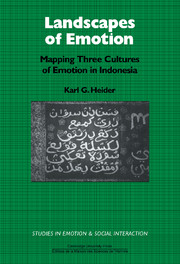Book contents
- Frontmatter
- Contents
- Acknowledgement
- PART I THEORY, METHOD, AND RESULTS
- 1 Theoretical introduction
- 2 Mapping the realm of emotion
- 3 Membership in the realm of emotion: prototypicality
- 4 Emotion scenarios: antecedents and outcomes
- 5 Comparisons between languages
- 6 The composite maps of emotion terms, cluster by cluster
- 7 Conclusions
- PART II A CLUSTER-BY-CLUSTER ANALYSIS OF THE COMPOSITE MAPS OF EMOTION TERMS
- Bibliography
- Author index
- Subject index
7 - Conclusions
Published online by Cambridge University Press: 22 October 2009
- Frontmatter
- Contents
- Acknowledgement
- PART I THEORY, METHOD, AND RESULTS
- 1 Theoretical introduction
- 2 Mapping the realm of emotion
- 3 Membership in the realm of emotion: prototypicality
- 4 Emotion scenarios: antecedents and outcomes
- 5 Comparisons between languages
- 6 The composite maps of emotion terms, cluster by cluster
- 7 Conclusions
- PART II A CLUSTER-BY-CLUSTER ANALYSIS OF THE COMPOSITE MAPS OF EMOTION TERMS
- Bibliography
- Author index
- Subject index
Summary
The influence of culture on emotion
The central challenge of this study is to specify the extent to which different cultures have different patterns of emotion behavior and to develop the case for that linkage between emotion and culture in either causal or holistic terms. In fact, convincing causal links are notoriously difficult to establish. It is unlikely that climate, population density, gene pool, or the like will turn out to have a causal effect on local emotion behavior. But holistic interrelationships can be described. For example, an Indonesian configuration of “anger” can be related to an overall pattern of conflict avoidance.
The study was designed to contrast Minangkabau and Javanese; Minangkabau speaking Indonesian with Minangkabau speaking Minangkabau; males with females; and, in a less direct comparison, these Indonesian languages and cultures with American English and European patterns.
But what can we expect to find? Our expectations can be based on one of three main schools of thought:
The pan-cultural universalism of those who simply ignore the possible effect of different cultures. Here are found especially psychologists who investigate emotion with “American” subjects on the implicit assumption that the differences among the cultural patterns within the United States are insignificant. And also those (like Jerry Boucher) whose studies generalize to the point that cultural differences are smoothed over, with the result that there is an apparent pan-cultural uniformity in facial expression and physiological concomitants of emotion. emotion. To the extent that these psychologists recognize cultural differences they characterize them as mere ethnographical epiphenomena.
[…]
- Type
- Chapter
- Information
- Landscapes of EmotionMapping Three Cultures of Emotion in Indonesia, pp. 87 - 128Publisher: Cambridge University PressPrint publication year: 1991



